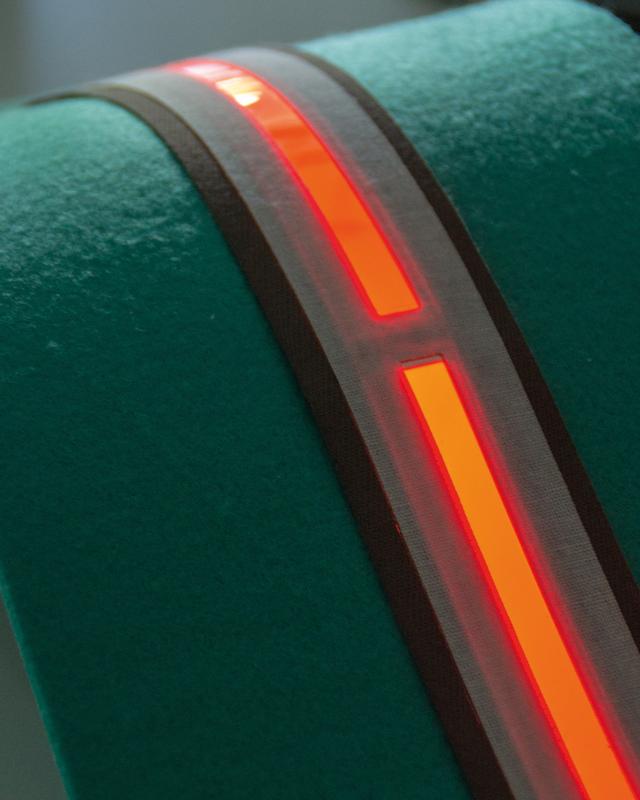Modular OLED light strips

OLED luminous strips enable luminous surfaces with segmented control - luminous stripe © Fraunhofer FEP Picture in printable resolution: www.fep.fraunhofer.de/press
Almost everyone is familiar with light strips for interior design. LED strips are available by the metre in DIY stores around the corner and are just as often found as under-cabinet luminaires or in decorative articles. But also in the automotive industry the demand for light strips is enormous. Customized strips with additional functionalities play an increasingly important role, especially in the area of innovative car designs.
Scientists at the Fraunhofer FEP have now succeeded in producing light strips from individual organic light-emitting diodes (OLEDs). What is special about this innovation is that the OLED light strips act like a single luminous surface without interruption.
Claudia Keibler-Willner, head of the “Sheet-to-sheet OLED Technologies” department at Fraunhofer FEP, explains this effect in more detail: “We manufacture flexible OLEDs with appropriate control electronics in such a way that any number of OLED modules can be connected without creating visible interruptions to the active surface.
This makes it possible to produce infinitely long OLED light strips. An additional highlight is the individual control of the segments. This allows additional lighting effects such as different dimmings or dynamic warnings to be realized.”
But why actually use OLEDs for car interiors or luminous clothing instead of using existing LED technology? The enormous advantage of OLEDs lies in their properties as area light sources. In contrast to LEDs as point light sources, OLEDs illuminate surfaces and are therefore homogeneous.
As a result, OLED strips require no reflectors, light guides or additional optics. They also impress with their extremely low Installation depth and light weight. This filigree quality of flexible OLEDs, which are manufactured on plastic substrates, for example, can hardly be achieved with conventional LED technology. In addition, the reduction of glare effects contributes to increased road safety, for example in safety clothing with lighting.
The OLED can make particularly good use of these advantages in the developed modular light strips of any length: OLED strips can be flexibly applied to curved surfaces such as car bodies or furniture. They can be transparent when switched off so that the underlying surface remains visible. Thus the OLEDs almost melt into their surroundings. Dynamic control or dimming opens up additional possibilities, such as for welcoming scenarios at the car. Designer dreams for interior design are thus within reach.
The scientists are now looking forward to concrete industry inquiries to develop prototypes or small series of these light strips for innovative designs and applications.
Fraunhofer FEP at the International Symposium on Automotive Lighting 2019 (ISAL):
Science & Congress Centre Darmstadtium
www.isal-symposium.de
Booth no: 37
Press contact:
Ms. Annett Arnold
Fraunhofer Institute for Organic Electronics, Electron Beam and Plasma Technology FEP
Phone +49 351 2586 333 | presse@fep.fraunhofer.de
Winterbergstraße 28 | 01277 Dresden | Germany | www.fep.fraunhofer.de
Media Contact
All latest news from the category: Trade Fair News
Newest articles

First-of-its-kind study uses remote sensing to monitor plastic debris in rivers and lakes
Remote sensing creates a cost-effective solution to monitoring plastic pollution. A first-of-its-kind study from researchers at the University of Minnesota Twin Cities shows how remote sensing can help monitor and…

Laser-based artificial neuron mimics nerve cell functions at lightning speed
With a processing speed a billion times faster than nature, chip-based laser neuron could help advance AI tasks such as pattern recognition and sequence prediction. Researchers have developed a laser-based…

Optimising the processing of plastic waste
Just one look in the yellow bin reveals a colourful jumble of different types of plastic. However, the purer and more uniform plastic waste is, the easier it is to…



